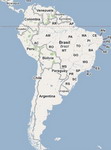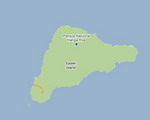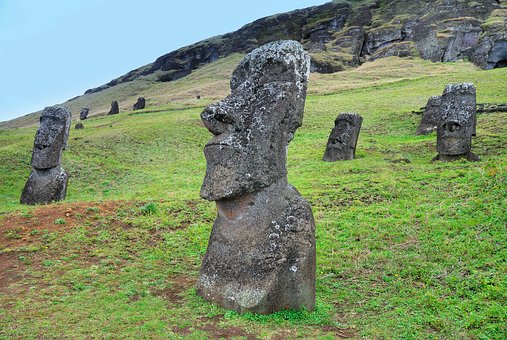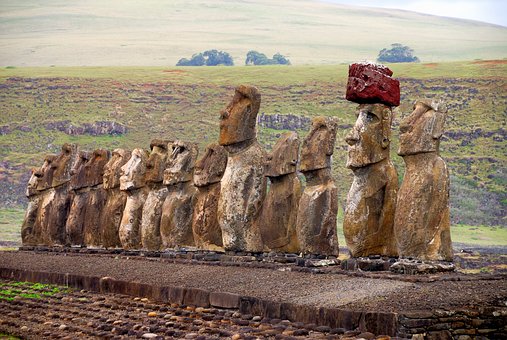Travel Guide to Chile:
5
Fun Facts to Know About Chile
A
Hiking Guide to Easter Island
Chile:
Land of Poets
Chile
Travel: Visiting the Lake District from Puerto Varas
Chile
Travel Destinations & Places To Visit in Chile
Concepcion
Guide
Discover
the beauty of San Pedro de Atacama
History
and Growth of Santiago de Chile
History
of Chile
Sightseeing
in Punta Arenas - Chile
Revealing
the Valleys of Chile
Swept
Away In Santiago De Chile
The
Mythology of Easter Island
Travel
to Valparaiso, Chile
A
Hiking Guide to Easter Island by David Stanley
Browse
accommodation for Isla de Pascua (Easter Island)
Ask me which Pacific island
has the most to offer hikers and I'll probably answer Easter Island. Here
on an island 11 km wide and 23 km long you'll find nearly a thousand ancient
Polynesian statues strewn along a powerfully beautiful coastline or littering
the slopes of an extinct volcano.
The legends of Easter Island
have been recounted many times. What's less known is that the island's
assorted wonders are easily accessible on foot from the comfort of the
only settlement, Hanga Roa. Before setting out see the sights, however,
visit the excellent archaeological museum next to Ahu Tahai on the north
side of town (the term "ahu" refers to an ancient stone platform). Aside
from the exhibits, the museum has maps which can help you plan your trip.
On online map is available at http://www.mapsouthpacific.com/easter_island/
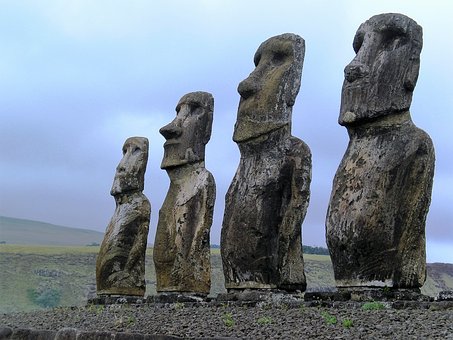
The first morning after arrival,
I suggest you climb Easter Island's most spectacular volcano, Rano Kau,
where Orongo, a major archaeological site, sits on the crater's rim. But
rather than marching straight up the main road to the crater, look for
the unmarked shortcut trail off a driveway to the right just past the forestry
station south of town.
It takes under two hours
to cover the six km from Hanga
Roa to Orongo, but bring along a picnic lunch and make a
day of it. (If climbing a 316-meter hill sounds daunting, you can take
a taxi to the summit for around US$6 and easily walk back later in the
day.)
Once on top, you'll find
hiking down into the colourful crater presents no difficulty. It may also
look easy to go right around the crater rim, but only do so if you're a
very experienced hiker and have a companion along as sheer 250-meter cliffs
drop into the sea from the ridge.
Another day, rise early and
take a taxi to lovely Anakena Beach at the end of the paved road on the
north side of the island (you should pay under US$10 for the 20 km). A
few of the famous Easter Island statues have been restored at Anakena and
you could go for a swim, although the main reason you've come is the chance
to trek back to Hanga Roa around the road-free northwest corner of the
island.
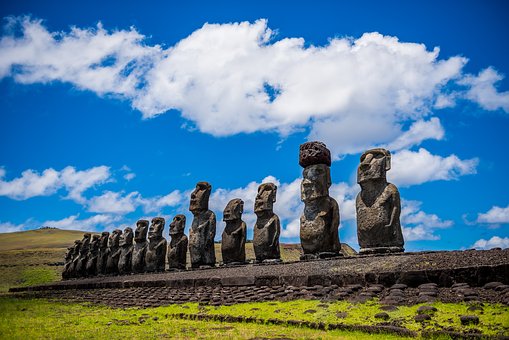
You'll pass numerous abandoned
statues lying facedown where they fell, and the only living creatures you're
unlikely to encounter are the small brown hawks which will watch you intently
from perches on nearby rocks. If you keep moving, you'll arrive back in
town in five or six hours (but take adequate food, water, and sunscreen).
This is probably the finest coastal walk in the South Pacific.
Almost as good is the hike
along the south coast, although you're bound to run into other tourists
here as a paved highway follows the shore. Begin early and catch a taxi
to Rano Raraku, the stone quarry where all of the island's statues were
born. This is easily the island's most spectacular sight with 397 statues
in various stages of completion lying scattered around the crater. And
each day large tour groups come to Rano Raraku to sightsee and have lunch.
However, if you arrive before 9 am, you'll have the site to yourself for
a few hours. When you see the first tour buses headed your way, hike down
to Ahu Tongariki on the coast, where 15 massive statues were reerected
in 1994. From here, just start walking back toward Hanga Roa (20 km) along
the south coast. You'll pass many fallen statues and enjoy some superb
scenery. Whenever you get tired, simply go up onto the highway and stick
out your thumb and you'll be back in town in a jiffy.
An outstanding 13-km walk
begins at the museum and follows the west coast five km north to Ahu Tepeu.
As elsewhere, keep your eyes
pealed for banana trees growing out of the barren rocks as these often
indicate caves you can explore. Inland from Ahu Tepeu is one of the island's
most photographed sites, Ahu Akivi, with seven statues restored in 1960.
From here an interior farm road runs straight back to town (study the maps
at the museum carefully, as you'll go far out of your way if you choose
the wrong road here).
A shorter hike takes you
up Puna Pau, a smaller crater which provided stone for the red topknots
that originally crowned the island's statues. There's a great view of Hanga
Roa from the three crosses on an adjacent hill and you can easily do it
all in half a day. A different walk takes you right around the 3,353-meter
airport runway, which crosses the island just south of town.
Near the east end of the
runway is Ahu Vinapu with perfectly fitted monolithic stonework bearing
an uncanny resemblance to similar constructions in Peru.
Easter Island's moderate
climate and scant vegetation make for easy cross country hiking, and you
won't find yourself blocked by fences and private property signs very often.
You could also tour the island by mountain bike, available from several
locations at US$10 a day. If you surf or scuba dive, there are many opportunities
here. A minimum of five days are needed to see the main sights of Easter
Island, and two weeks would be far better. The variety of things to see
and do will surprise you, and you'll be blessed with some unforgettable
memories.
Browse
accommodation for Isla de Pascua (Easter Island)
Top
|


